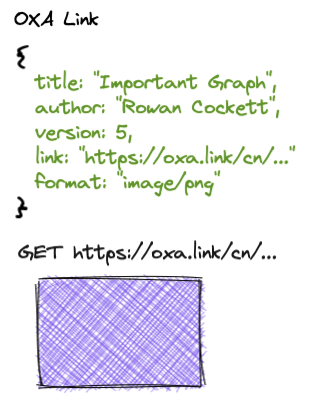oxa.link
An OXA Link (Object Cross-reference Abstraction) is a cross-reference to an evolving piece of content (text, image, code-snippet), an object, that maintains attribution and licensing information such that it can be reused by other people in traditional office products and on the web. An OXA Link provides an abstraction over various open-access content repositories (e.g. GitHub, Wikipedia, Zenodo, Curvenote).
The purpose of the abstraction is to provide infrastructure to reuse components of open-access content. For example, textbooks, preprints, posters, websites, and presentations often share figures, equations or even sections of text. Today the way that these components are shared is by copying and pasting content, for example, copying an image from a computational notebook into a presentation, textbook or scientific article.

This manual action of copy-paste severs the connection to the data-source, and any ability to automatically update if a new version becomes available. Additionally, much if not all of the metadata necessary for attribution or reproduction is lost. This lack of reproducibility can be mitigated if a project uses automated techniques to regenerate files (e.g. Makefiles and build-pipelines). However, even with automated builds of artifacts: (1) any reuse downstream is limited (e.g. a colleague reusing a figure in a different project, repository or presentation); (2) these techniques don’t work well with many commonly used “point-and-click” tools (e.g. Google Slides or PowerPoint); and (3) metadata about the reproduction process and attribution is not included in the distributed artifacts, or is included ad-hoc in text citations.
An OXA Link maintains attribution of these components, enabling distributed version control, cross-project collaboration, and automated updates. In the same way that the DOI (Digital Object Identifier) enabled improved reference management and the scholarly graph, the OXA Link provides improved content management in the context of evolving, open-access knowledge.
In the above example, a user can save their source file to a versioned content repository and then reference that component in an article or presentation by wrapping the component in a OXA Link. As this is simply a standard HTTP link, all common document formats already support OXA Links, however, to make full use of them a plugin or script is necessary (more on that below!). The link provides an API abstraction over multiple content repositories with attribution and version information as well as a direct link to the content. The service does not store the content directly, instead it abstracts over open-access content repositories providing access to versioned content in a specific format.

Made with love by
![]() Curvenote
Curvenote